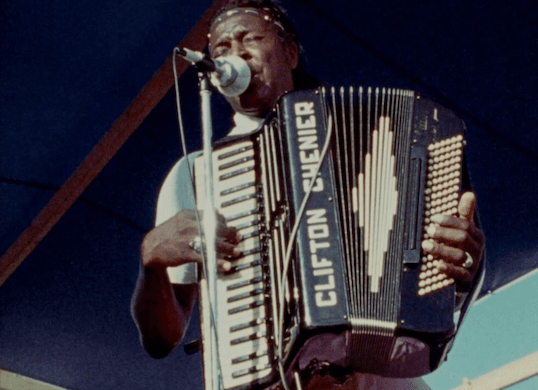American Vernacular Music, as Preserved by a Most Unassuming Anthropologist
Time waits for no man, but Les Blank surely was not going to let it steamroll his quirks without capturing them on film. A restored version of his disarming overview of Zydeco and Cajun music, ‘I Went to the Dance’ (1989), is now being re-released.

The documentary filmmaker Les Blank, who died in 2013 at the age of 77, did the lord’s work. Likely best known for “Garlic is as Good as Ten Mothers” (1980), “Burden of Dreams” (1982), and “Gap Toothed Women” (1987), Blank’s primary enterprise was the chronicling of American vernacular music. From Dizzy Gillespie and Lightnin’ Hopkins to Clifton Chenier and the Wild Tchoupitoulas, Blank set out to valorize cultural byways that were off the beaten commercial path. In doing so, he preserved many of them for the historical record.
Of course, there was that venture with, of all people, Huey Lewis and the News, and “A Poem is a Naked Person,” a project commissioned and subsequently quashed by the musician Leon Russell. Still, Blank’s heart was down with the people and, especially it seems, those ensconced in rural Louisiana. For his efforts, Blank received any number of accolades and honors, including the American Film Institute’s Maya Deren Award for “outstanding lifetime achievement.” Although his reputation isn’t far-ranging, it does cut deeply for those wise to his accomplishments as the most unassuming of anthropologists.
An abiding fondness for idiosyncrasy and ethnic food mark his documentaries, as does, it should be admitted, a gentle strain of noblesse oblige. “I try to show that the people in my films are human beings who have just as much right to be on this earth as anybody else. Maybe more right.” If Blank can be faulted for romanticizing the margins of culture, he should be applauded for holding true to the quiddities of localism. Time waits for no man, but Blank surely was not going to let it steamroll his quirks without capturing them on film.
“I Went to the Dance” (1989), a disarming overview of Zydeco and Cajun music, is being re-released in a version that has been restored, remastered, and otherwise put right. It offers an object lesson in the complications, contradictions, and, in the end, tangible rewards of what can only be called the American experiment. After a short clip of a convivial Queen Ida — who refers to Louisiana as a country behind “the iron curtain” of the United States — Blank capitulates to conventional documentary form by running an abbreviated text outlining the historical markers that went into shaping the music.
It’s a story about the promiscuous commingling of cultures, beginning in 1755 when the British expelled French-speaking Acadians out of Nova Scotia, resulting in their trek to the bayous of Louisiana. The Acadians set down roots in a community composed of Free Men of Color, Native Americans, and other European settlers. The Irish had a strong hand in shaping the keening tonalities of Cajun music, but the most sweeping influence was that of Black Creoles. The latter, folklorist Barry Jean Ancelet explains, are pivotal in understanding the difference between Acadian and Cajun music.
Toward the beginning of “I Went to the Dance,” a player and maker of accordions, Marc Savoy, provides a step-by-step explanation — a recipe, really — of Cajun music. After extolling the benefits of the accordion in terms of volume (loud) and durability (tough), Mr. Savoy runs through the seven notes that “tell the story.” He plays “J’ai Passe Devant Ta Porte,” all the while elaborating on “the simple melody” by making eighth notes out of full notes, pushing and drawing the octaves and chords, and then adding “the little embellishments that make it ornate.” It is the last step that proves the most illusive and, wouldn’t you just know it, the most magical.
Blank inventories a variety of musicians whose fame didn’t extend much beyond the region. You’ve likely never heard of Iry LeJeune, whose death in an auto accident at age 26 didn’t prevent him from racking up significant sales, or the eerie wail of Cléoma Falcon, who, with her husband Joe Falcon, recorded “The Waltz That Carried Me To My Grave,” among the first pieces of Cajun music put to wax. We follow the genre as it encounters bumps in the road — foremost among them, the advent of rock ’n’ roll — and how the folk revival of the 1960s proved indispensable in shining a new light on that distinctive wail and those scurrying rhythms.
How Cajun and Zydeco are faring in the here-and-now is a good question. A quick surf of the web shows that Wayne Toups, seen in “I Went to the Dance” as a testosterone-charged 20-something, is still at it and, from the looks of it, he’s at it hard. “Always for Pleasure,” the title of an earlier Blank documentary, was the director’s modus operandi and a sentiment that proves just as apt for this modest slice of subcultural reportage.

